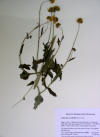|
Verbensina encelioides |
Verbensina encelioides |
|
Verbensina encelioides |
|
|
Botta B., M. Carmignani, A. R. Volpe, M. Botta, F. Corelli and G. Delle Monache. 2003. Novel hypotensive agents from Verbesina caracasana: structure, synthesis and pharmacology. Curr. Med. Chem. 10(18): 1845–1862. “The number and the pharmacological activities of drugs featuring a guanidine group is actually amazing. Many synthetic guanidine derivatives have attracted pharmacologists in search of new antihypertensive drugs for their ability to block adrenergic nerve activity through central and/or peripheral mechanisms. As a result, compounds such as guanethidine, guanabenz, guanfacine, and pinacidil have been introduced in antihypertensive drug therapy. A crude methanol extract of the Venezuelan plant Verbesina caracasana Fries (Compositae), intravenously administered to mice, was found to induce biological effects such as erection of hair, initial stimulation and subsequent blockade of breathing. Biologically controlled purification yielded a series of active guanidine derivatives, namely G1-G7, which were extensively studied with the focus on the following items: (1) The structure determination of the active compounds by spectral data and a set of reactions; (2) The confirmation of the structures by a biogenetically oriented synthesis; (3) The study of the pharmacological profiles of the isolated drugs; (4) The synthesis of analogous and homologous products in the effort to shed some light on the structure-activity relationship. The metabolites of V. caracasana were characterized, in anesthetized rats, as hypotensive drugs of high (G2), mild (G1, G7) and low (G3,G5,G6) potency, devoid of consistent actions in heart rate, and provided with moderate stimulatory effects on cardiac inotropism and breathing (at selected non-toxic intravenous doses). Autonomic neurogenic components and/or peripheral adrenergic and cholinergic receptor-related pathways were involved in the cardiovascular effects. Synthetic analogs and homologs of G1 and G5 were all shown to be hypotensive drugs of low-mild potency, not affecting appreciably cardiac inotropism and/or breathing. The pharmacodynamic differences among the studied compounds were likely to depend on their ability to cross the blood-brain barrier, lipophilicity and pharmacokinetics. Since most of the compounds did not induce reflex tachycardia and depression of myocardial contractility as the majority of the antihypertensive drugs, they might be useful in the treatment of arterial hypertension of various genesis.” Lopez TA, Campero CM, Chayer R, Cosentino B, Caracino M. 1996. Experimental toxicity of Verbesina encelioides in sheep and isolation of galegine. Vet. Hum. Toxicol. 1996 Dec;38(6):417–419. “Verbesina encelioides is a widely distributed weed in Argentina. Although it has been suspected as poisonous, there seem to be no previous reports of its toxicity in this country. Its biological activity was evaluated through an experiment in sheep. Four 5-y-old sheep, averaging 33 kg in body weight, were given a single dose of 1.0, 3.2, 5.0 or 6.3 g of dried plant material (17.9% dry matter)/kg body weight orally in a water suspension. Forty-eight hours later, the animals given 5.0 g or 6.3 g showed dullness and lack of appetite. The higher dosed sheep became recumbent a few hours later and died 60 h after dosing without showing further signs. The other animals showed no signs. Necropsy of the dead sheep showed severe lesions in different organs: liver, kidneys, lungs, lymph nodes and digestive tract. Hydrothorax was also observed. The animal receiving 5.0 g/kg was sacrificed after 72 h to determine the degree of recovery or lesions. Microscopically, severe glomerulonephrosis and congestion in the liver, with cellular degeneration and fatty changes were observed. Additionally, hemorrhagic lymph nodes, and hemorrhagic and edematous lungs were noted. No gross nor microscopic lesions were found in the sheep receiving 5.0 g/kg. Mice injected ip with the chromatographic extract died in less than 15 min. Galegine was identified in the plant material. The minimum toxic dose of 5-6 g/kg indicates a high toxicity when compared to other poisonous plants of the southeastern area of Buenos Aires province, Argentina. ” Panero J. L., R. K. Jansen and J. A. Clevinger. 1999. Phylogenetic relationships of subtribe Ecliptinae (Asteraceae: Heliantheae) based on chloroplast DNA restriction site data. Am. J. Bot. 86(3): 413. “Phylogenetic analysis of chloroplast DNA restriction site data for 76 of the 302 genera of Heliantheae sensu lato using 16 restriction endonucleases reveals that subtribe Ecliptinae is polyphyletic and that its genera are distributed in four different lineages. The ecliptinous genera Squamopappus, Podachaenium, Verbesina, and Tetrachyron (of the Neurolaeninae), along with other members of subtribe Neurolaeninae are the basalmost clades of the paleaceous Heliantheae. The mostly temperate species of subtribe Ecliptinae (exemplified by Balsamorhiza, Borrichia, Chrysogonum, Engelmannia, Silphium, Vigethia, and Wyethia) are strongly nested in a clade with the Mesoamerican monotypic genus Rojasianthe as basal. The genera characterized by marcescent ray corollas traditionally classified in subtribe Zinniinae constitute a strongly supported group sister to Acmella, Spilanthes, and Salmea. The largest clade of ecliptinous genera is the most recently derived group within Heliantheae sampled. This large group of mostly Neotropical lowland genera (variously characterized by their winged cypselae, foliaceous phyllaries, and opposite phyllotaxy and exemplified by Perymenium, Wedelia, and Zexmenia) has been and continues to be the most challenging group from a taxonomic standpoint. The study provides new insights as to their relationships that will have a positive impact in future monographic studies of the group. The genera of the Espeletiinae form a monophyletic clade and are sister to members of the Milleriinae and Melampodiinae. This result is consistent with their traditional taxonomic placement with genera such as Smallanthus with which they share a tendency for functionally staminate disc flowers. The phylogenetically enigmatic genus Montanoa is sister to Melampodium. Members of subtribe Galinsoginae are clustered in two main lineages that correspond to the traditional division of the subtribe based on pappus characteristics. There is no support for the monophyly of subtribe Galinsoginae, and the same results indicate some of its genera are paraphyletic.”
|
|



